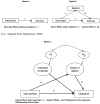Direct and Mediated Effects of a Social-Emotional and Character Development Program on Adolescent Substance Use
- PMID: 24308013
- PMCID: PMC3845413
Direct and Mediated Effects of a Social-Emotional and Character Development Program on Adolescent Substance Use
Abstract
Mitigating and preventing substance use among adolescents requires approaches that address the multitude of factors that influence this behavior. Such approaches must be tested, not only for evidence of empirical effectiveness, but also to determine the mechanisms by which they are successful. The aims of the present study were twofold: 1) To determine the effectiveness of a school-based social-emotional and character development (SECD) program, Positive Action (PA), in reducing substance use (SU) among a sample of U.S. youth living in a low-income, urban environment, and 2) to test one mechanism by which the program achieves its success. We used longitudinal mediation analysis to test the hypotheses that: 1) students attending PA intervention schools engage in significantly less SU than students attending control schools, 2) students attending PA intervention schools show significantly better change in SECD than students attending control schools, and 3) the effect of the PA intervention on SU is mediated by the change in SECD. Analyses revealed program effects on both SECD and SU, a relationship between SECD and SU, and the effects of PA on SU were completely mediated by changes in SECD. Future research directions and implications for school-based social-emotional and character development efforts and substance use prevention are addressed.
Keywords: Adolescence; Longitudinal; Mediation; Social-emotional; Substance Use.
Conflict of interest statement
Figures


References
-
- Achenbach TM. Manual for the Child Behavior Checklist/4-J8 and 1991 profile. Burlington: University of Vermont; 1991.
-
- Althof W, Berkowitz MW. Moral education and character education: Their relationship and roles in citizenship education. Journal of Moral Education. Special Issue: The Moral Roots of Citizenship and Citizenship Education. 2006;35:495–518. doi: 10.1080/03057240601012204. - DOI
-
- Bar-On R. Bar-On EQ-i:S Technical Manual. Toronto: Multi-Health Systems; 2002.
-
- Baron RM, Kenny DA. The moderator-mediator variable distinction in social psychological research: Conceptual, strategic, and statistical considerations. Journal of Personality and Social Psychology. 1986;51:1173–1182. 0022-3514/86/ - PubMed
-
- Beets MW, Flay BR, Vuchinich S, Snyder FJ, Acock A, Li KK, et al. Use of a social and character development program to prevent substance use, violent behaviors, and sexual activity among elementary-school students in Hawaii. American Journal of Public Health. 2009;99:1438–1445. doi: 10.2105/AJPH.2008.142919. - DOI - PMC - PubMed
Grants and funding
LinkOut - more resources
Full Text Sources
Medical
